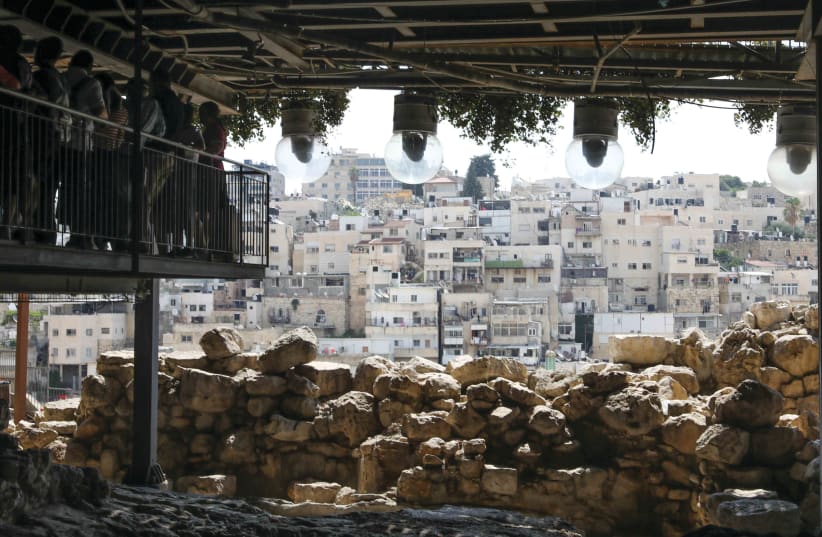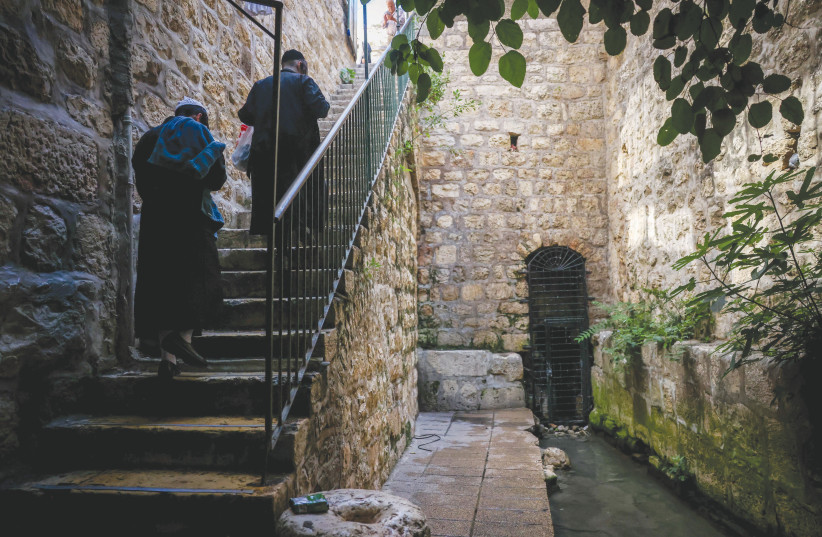
Here in Jerusalem, we know that we walk with history. Every step we take through this significant city, of immense importance to the three major monotheistic religions, transports us back to the land of our forefathers. No neighborhood symbolizes the importance of this connection quite like the City of David, or Ir David in Hebrew.
Situated just outside the walls of the Old City, the City of David stands as a living witness to Jewish Jerusalem’s rise and fall. This historic neighborhood, located to the south of the Old City, traces its roots back over 3,000 years to King David, from whom it derives its name.
Today, the City of David remains a captivating blend of archaeological wonder and contemporary life, offering visitors a compelling journey through layers of civilizations that have shaped the landscape of Jerusalem.
As one navigates through the narrow streets and ancient ruins, the City of David unfolds as a living museum, revealing archaeological treasures that illuminate the city’s biblical past. But beyond its archaeological significance, this neighborhood is home to a small but vibrant community where residents and visitors alike can breathe in Jerusalem’s history and experience the modern-day difficulties of life in our eternal capital while trying to live alongside their Palestinian neighbors.
History of the City of David
The story of the City of David unfolds across millennia, beginning with its origins rooted in the days of Abraham. Situated around the revered Gihon Spring in ancient Jerusalem, this fortified Canaanite city flourished over 3,000 years ago.
It was here that the Jewish King David, leaving his city of Hebron, ascended to Jerusalem with the vision of uniting Israel under a single capital. With the conquest of the Jebusites, David established Jerusalem as the prosperous capital of a burgeoning kingdom. His son Solomon solidified its significance by erecting the Holy Temple atop Mount Moriah, the sacred site where, according to biblical tradition, Abraham’s son Isaac was bound for sacrifice.
Thus, Jerusalem burgeoned into a nexus of politics, religion, and spirituality for the people of Israel. Today, the echoes of this storied past resonate within the City of David National Park, nestled on a captivating hill adjacent to the Western Wall, just south of Dung Gate. Visiting this site is akin to stepping into the annals of kings and prophets, where biblical narratives unfolded and scriptural texts were birthed.
The City of David stands as a vital archaeological treasure trove for Israel, at the heart of ancient Jerusalem during the Bronze and Iron ages. Spread out over 11 archaeological sites to the west of the Kidron Valley, its ancient remnants date back to the Middle Bronze Age, featuring defensive structures encircling the Gihon Spring. Notable discoveries, such as the Large Stone Structure and the Stepped Stone Structure, have sparked scholarly discourse, with debates centered on their potential ties to King David and later epochs. The Siloam Tunnel, traditionally attributed to Hezekiah’s reign in the 8th century BCE, reveals intriguing evidence suggesting a more ancient origin.
Under the stewardship of the Israel Nature and Parks Authority and managed by the Ir David Foundation (Elad), the City of David rests within Wadi Hilweh, encompassing the Palestinian neighborhood of Silwan. The appellation “City of David” harks back to biblical narratives recounting King David’s Jerusalem conquest, although its historical authenticity remains a subject of contention. Embracing its Canaanite heritage, the area is also recognized by its Arabic name, Wadi Hilweh.
Archaeologically, the City of David epitomizes Jerusalem’s ancient core, stretching from the Temple Mount to the Pool of Siloam, covering approximately 50 dunams. While traces of early settlement date back to the Chalcolithic and Early Bronze ages, Solomon’s era witnessed the city’s expansion northward with the Temple Mount’s inclusion. Scholarly deliberations over the site’s identity as biblical Jebus and the City of David have persisted since the late 19th century, with ongoing excavations unraveling layers of history spanning from the Bronze Age to the Early Roman period.
Recent excavations by the Israel Antiquities Authority near the Gihon Spring have unveiled Iron Age II relics, illuminating the site’s ancient past. However, interpretations of biblical narratives chronicling King David’s reign diverge among scholars, with discussions delving into historical accuracy and theological perspectives. Despite scholarly debates, the City of David endures as an indispensable locus for comprehending Jerusalem’s formative years and biblical resonance within the tapestry of ancient Near Eastern history. Step into this cradle of civilization, where stones whisper tales of empires and faith that echo across millennia.
The modern City Of David
The modern-day Jewish neighborhood of the City of David is located in the Wadi Hilweh part of Silwan, situated in east Jerusalem, and was captured by Israel in the 1967 Six Day War following 19 years of Jordanian rule. The City of David’s inclusion in modern Jerusalem’s boundaries was ratified in the 1980 Jerusalem Law, which stated that the whole city was the complete and united capital of Israel.
The Wadi Hilweh neighborhood spans the historical southeast hill of Jerusalem, extending from the southern walls of the Old City. Over time, Silwan expanded from its origins on Ras al-Amud in the 12th century to encompass the southeast hill by the early 20th century. Arab families have continued to live and build homes in this area post-1967.
The Ir David Foundation also helps facilitate the settlement of Jewish families in Silwan by purchasing properties in the area. Some of these homes were originally owned by Jews prior to the establishment of the modern Jewish state, reflecting the historic Jewish settlement of Kfar Shiloah, which was founded in the late 19th century for immigrants from Yemen. As of 2009, the foundation has housed 75 Jewish families in properties it owns.
Through a variety of methods, the foundation acquires property in the City of David and its environs. Firstly, it identifies assets that belonged to Jews in the City of David and takes legal steps to return them to their original Jewish owners. Secondly, it purchases properties classified as absentee property, though there have been allegations of dubious utilization of the Israeli Absentees Property Law. Additionally, the foundation persuades Arab residents to voluntarily sell their homes to Jewish buyers. Acquiring property directly from Muslims poses a challenge due to Waqf law, which prohibits Muslims from selling land to Jews, as it is considered Allah’s property. To navigate this restriction, Elad employs Muslim middlemen as brokers to facilitate property transactions.
In September 2014, the Ir David Foundation assisted residents in moving into 25 apartments in Silwan, marking the foundation’s largest acquisition to date. These apartments were part of seven different buildings purchased by the Ir David Foundation through a US-based intermediary organization.
Walking through the Jewish neighborhood of the City of David is a rare chance to see ancient Jewish history and modern Israeli life come together side by side. As one strolls through the neighborhood, Jewish houses dot the hillside on the steep slopes down into the Kidron Valley, with gateways and door posts adorned with colorful flowers and decorative name plates at the entrances to houses. It can all give the appearance of strolling through a neighborhood anywhere in the world, and one forgets for a brief time the geopolitical undertones that run through the City of David.
At the last count, Silwan was home to approximately 700 Jews, and they are made of sturdy stuff. One has to be resilient to live in Silwan, so close to the heart of the Israeli-Palestinian conflict. The sensitivity surrounding the neighborhood was demonstrated when In Jerusalem asked residents to discuss what life was like living in the City of David, but inhabitants are allowed to speak to the media only with the permission of the neighborhood association.
Wadi Hilweh has become a focal point of archaeological exploration and Israeli activity in recent years. In terms of development projects, controversy has arisen over plans to establish touristic and archaeological parks, potentially displacing Palestinian homes and altering the landscape. Projects like the cable car initiative linking the First Station compound to the Kedem visitor center in Silwan/City of David have faced legal challenges and scrutiny, often associated with the Elad organization. The management and development of archaeological sites like the City of David have been sources of ongoing tension and debate, reflecting broader geopolitical and ideological conflicts in the region.


